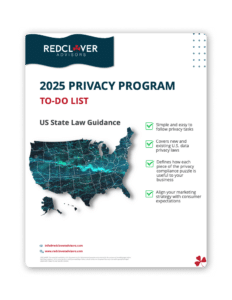Remember that scene in “Minority Report” where Tom Cruise walks through a mall while personalized ads call out his name? Well, we’re not quite there yet (thankfully), but 2025’s privacy landscape is giving marketers plenty to lose sleep over. As a CMO, if you’re not already thinking about privacy compliance, you’re basically using Internet Explorer in a Chrome world – outdated and potentially dangerous.
The marketing landscape has shifted more dramatically than a Netflix algorithm during a true crime documentary binge. With privacy regulations proliferating faster than streaming services, CMOs are facing a perfect storm of compliance challenges. We’re talking new US state privacy laws, budding AI regulations, major privacy changes in tech.
Let’s dive into the top three privacy concerns that should be on every CMO’s radar in 2025, and unlike your New Year’s resolution to hit the gym, these can’t be postponed. These aren’t just regulatory checkboxes to tick off – they’re fundamental shifts in how we approach digital marketing and customer relationships. Think of this as your privacy survival guide for 2025, where we’ll navigate the complexities of modern privacy requirements with the grace of a cat landing on its feet (or at least try to).
1. The Consent Conundrum: It’s Not Just About Clicking ‘Accept’ Anymore
Remember when getting consent was as simple as slapping a cookie banner on your website? In 2025, consent management is the new black, and it’s not just about checking boxes anymore. It’s about creating a transparent, user-friendly experience that makes your privacy practices clearer than your company’s mission statement.
Modern consent requirements need the following:
- Clear, affirmative action – Think of this as the “swiping right” of privacy. Users need to actively choose to share their data, not just passively accept it like those terms and conditions we all pretend to read (no more pre-checked boxes, folks)
- Freely given – If your privacy policy is longer than a Marvel movie credits sequence, you’re doing it wrong. Break it down into digestible chunks
- Specific – Users need to know exactly what they’re signing up for, like a dating profile but with actual honesty
- Informed – Spell out who’s getting the data, why they need it, and what they’re doing with it. Think of it as a “behind the scenes” feature for your data practices
- Unambiguous – If your consent process is more complicated than explaining the plot of Inception, you need to simplify it
Your consent management system needs to do the following:
- Track consent timestamps and trigger renewal requests when needed
- Store comprehensive records of what users consented to (and when)
- Allow users to modify their preferences easier than changing their Netflix password
- Automatically flag when processing activities change and new consent is needed
- Handle consent across all your digital touchpoints, from your main website to that forgotten marketing landing page from 2023
Remember, in 2025, getting proper consent is like getting a second date – it requires transparency, respect, and absolutely no ghosting when users want to change their minds about sharing data.
2. The Third-Party Cookie Apocalypse: The End is Actually Here
If you’ve been hitting “snooze” on the third-party cookie phase-out, it’s time to wake up and smell the privacy-compliant coffee. 2025 isn’t just about surviving without third-party cookies; it’s about thriving in the new era of first-party data and universal opt-out mechanisms. While Google did decide to no longer get rid of third-party cookies on Chrome, it’s now easier than ever for users to opt-out of tracking and third-party cookies.
Let’s break down what this actually means for your marketing stack:
The New Reality of First-Party Data
First-party data is now your marketing department’s best friend. But collecting it requires more finesse than a sommelier at a wine tasting. You need to:
- Build trust through transparent data collection practices
- Create value exchanges that make sharing data worth it (and no, a 5% discount code isn’t going to cut it anymore)
- Implement proper data governance faster than you can say “privacy by design”
- Actually use the data you collect (shocking, we know) in ways that benefit your customers
Universal Opt-Out Mechanisms: The New Sheriff in Town
The Global Privacy Control (GPC) is no longer that fancy new feature – it’s the new normal. Think of it as the “Do Not Call” list for the digital age, except this time, it actually works. Your website needs to recognize and respect these signals.
Here’s what you need to have in place:
- Automatic GPC signal detection and honoring (it’s not optional, folks)
- Clear visual indicators showing users their current privacy status
- Backend systems that can actually implement these preferences
- Regular testing of your opt-out mechanisms (because “it worked when we launched it” doesn’t cut it anymore)
The Hidden Data Sharing Gotchas
Not all data sharing happens through cookies. That seemingly innocent analytics tool? The social media plugins? They’re all potential privacy pitfalls waiting to happen. You need to audit:
- All third-party integrations (yes, even that ancient marketing pixel you forgot about)
- API connections and data transfers
- Server-side tracking implementations
- Social media embeds and share buttons
- That random chatbot your sales team insisted on adding
Think of it like spring cleaning, except instead of finding old socks, you’re finding potential privacy violations that could cost you more than your annual marketing budget.
The Solution: Building a Privacy-First Marketing Stack
Your 2025 marketing stack needs to be built like a premium Swiss Army knife – versatile, reliable, and compliant by design. This means:
- Implementing privacy-preserving analytics alternatives
- Developing first-party data strategies that don’t make users feel like they’re being stalked
- Creating contextual targeting approaches that work without personal data
- Building customer relationships based on trust rather than tracking
Remember: in 2025, being privacy-compliant is like having a smartphone – it’s not a competitive advantage anymore, it’s just table stakes.
3. The Profiling Paradox: Walking the Personalization Tightrope
Let’s talk about the elephant in the room – profiling and targeted advertising. In 2025, it’s like trying to walk a tightrope while juggling privacy compliance, customer experience, and regulatory requirements. One wrong move, and you’re viral for all the wrong reasons (and not the good kind of viral, like that cat video you can’t stop watching).
The New Rules of Personalization
Your targeted advertising strategy needs more transparency than a glass house. But here’s the thing – transparency doesn’t mean sacrificing effectiveness. It’s like dating: being upfront about your intentions usually works better than trying to be mysterious. Consumers need to know:
- What data you’re collecting (and why) – Break it down like you’re explaining TikTok to your grandparents
- Who you’re sharing it with – List those third parties like credits in a movie
- How they can opt out – Make it easier than canceling a gym membership
- What happens when they do opt out (and no, you can’t punish them for it) – No passive-aggressive “We’ll miss you” messages
The Art of Ethical Profiling
In 2025, profiling needs to be as ethical as your coffee sourcing. Here’s how to do it right:
- Use transparent profiling techniques
- Implement regular profiling audits (like spring cleaning, but for algorithms)
- Create clear documentation of your profiling logic (if it sounds creepy when you write it down, it probably is)
- Build in manual review processes for high-impact decisions
- Maintain “privacy by design” principles that would make a privacy lawyer proud
The Personalization Sweet Spot
Your 2025 personalization strategy should:
- Focus on contextual relevance over personal data hoarding
- Use aggregated data insights where possible (because sometimes, less really is more)
- Build trust through transparent communication about your personalization practices
- Offer genuine value in exchange for data (no, another newsletter subscription isn’t valuable)
- Create tiered personalization options that let users choose their comfort level
The Way Forward: Your Privacy Compliance Checklist
If all of this has you reaching for the aspirin (or something stronger), take a deep breath. We’ve created a comprehensive privacy compliance checklist.
What’s in the Checklist?
Our 2025 Privacy Compliance Checklist includes:
- Step-by-step consent management implementation guide
- Cookie opt-out mechanism blueprints
- Profiling and targeted advertising compliance frameworks
- State-specific privacy requirements breakdown
- Universal opt-out mechanism integration roadmap
- Dark pattern identification and elimination guide
- First-party data collection best practices
- Privacy-first marketing strategy templates
This checklist is your roadmap to:
- Building trust with your audience
- Staying ahead of regulatory requirements
- Creating effective, compliant marketing strategies
- Avoiding those pesky fines that make CFOs cry
2025 Privacy Checklist
Check out our Privacy Checklist for tips and practical guidance to establish a sustainable compliance program.

Remember, in the world of privacy compliance, being proactive is like having a good skincare routine – it’s always better than dealing with the damage later. Your future self (and your legal team) will thank you.


